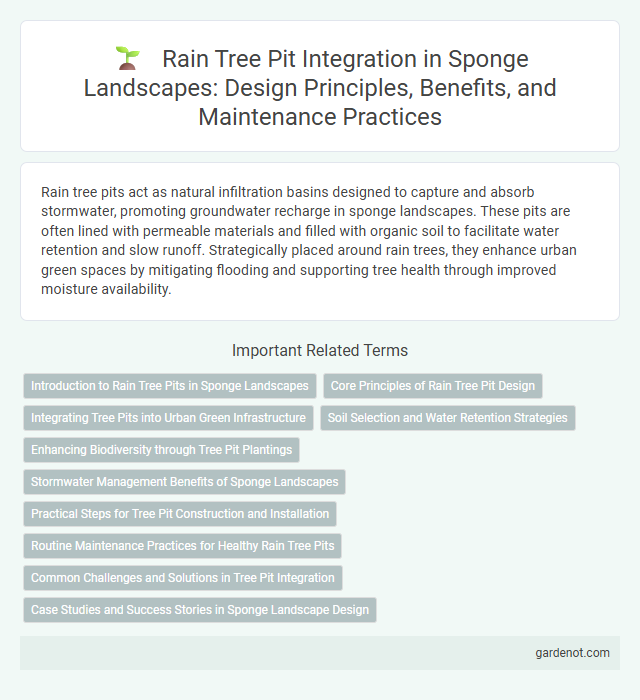Rain tree pits act as natural infiltration basins designed to capture and absorb stormwater, promoting groundwater recharge in sponge landscapes. These pits are often lined with permeable materials and filled with organic soil to facilitate water retention and slow runoff. Strategically placed around rain trees, they enhance urban green spaces by mitigating flooding and supporting tree health through improved moisture availability.
Introduction to Rain Tree Pits in Sponge Landscapes
Rain tree pits are specialized planting basins designed to enhance water absorption and retention in sponge landscapes, promoting sustainable urban drainage. These pits incorporate permeable materials and layered substrates to facilitate efficient infiltration while supporting rain tree growth and health. Rain tree pits play a critical role in managing stormwater runoff, reducing flood risks, and improving urban microclimates.
Core Principles of Rain Tree Pit Design
Rain tree pit design prioritizes effective stormwater capture, infiltration, and groundwater recharge to mitigate urban flooding and improve water quality. Incorporating porous soil media and bio-retention layers enhances filtration and supports tree health by optimizing oxygen availability to the root zone. Strategic placement and sizing based on rainfall intensity ensure efficient runoff management within sponge landscape systems.
Integrating Tree Pits into Urban Green Infrastructure
Rain tree pits serve as vital components in urban green infrastructure by enhancing stormwater management and supporting tree health. These pits, designed with permeable materials and soil layers, facilitate water infiltration and reduce surface runoff in densely paved areas. Integrating rain tree pits into city landscapes promotes biodiversity, lowers urban heat island effects, and improves air quality through natural filtration processes.
Soil Selection and Water Retention Strategies
Rain tree pits require soil with high organic content and excellent permeability to enhance water infiltration and retention. Using a well-balanced mixture of sandy loam and compost improves aeration and nutrient availability, supporting optimal root growth. Incorporating biochar or moisture-retentive polymers in the soil blend further boosts water retention, reducing runoff and drought stress in sponge landscapes.
Enhancing Biodiversity through Tree Pit Plantings
Rain tree pits support sponge landscape systems by capturing and filtering stormwater, creating microhabitats that foster diverse flora and fauna. Planting native species within these pits enhances soil health and promotes ecological balance, attracting pollinators and beneficial insects. This integration improves urban biodiversity while managing runoff in sustainable, natural ways.
Stormwater Management Benefits of Sponge Landscapes
Rain tree pits in sponge landscapes effectively capture and infiltrate stormwater, reducing surface runoff and minimizing flood risks in urban areas. These pits enhance groundwater recharge by allowing rainwater to percolate through permeable soils, promoting sustainable water cycles. The integration of rain tree pits improves water quality by filtering pollutants and sediments before water reaches natural water bodies.
Practical Steps for Tree Pit Construction and Installation
Effective rain tree pit construction begins with selecting a location that supports natural water infiltration, ensuring the pit measures at least 1.5 times the tree's root ball diameter for adequate soil volume and aeration. Installation requires layering with permeable materials such as gravel and coarse sand to facilitate stormwater drainage while preventing root waterlogging. Incorporating organic mulch and maintaining a slight slope towards the pit promotes moisture retention and reduces surface runoff, enhancing tree health and resilience.
Routine Maintenance Practices for Healthy Rain Tree Pits
Routine maintenance practices for healthy rain tree pits include regular removal of debris and fallen leaves to prevent clogging and promote proper water infiltration. Periodic inspection and pruning of surrounding vegetation ensure unobstructed growth and reduce root damage. Implementing aeration techniques and replenishing organic mulch supports soil health and enhances the sponge landscape's overall water retention capacity.
Common Challenges and Solutions in Tree Pit Integration
Rain tree pits often face challenges such as poor drainage, soil compaction, and limited nutrient availability, which hinder healthy root growth. Implementing permeable materials, proper grading, and organic soil amendments improves water infiltration and aeration, promoting tree vitality. Regular maintenance and monitoring help prevent root damage and ensure long-term sustainability of integrated rain tree pits in urban landscapes.
Case Studies and Success Stories in Sponge Landscape Design
Rain tree pits have proven effective in multiple sponge landscape projects worldwide, significantly improving stormwater management and groundwater recharge. Case studies from Singapore's urban parks demonstrate up to 40% reduction in surface runoff and enhanced tree health through optimized rain tree pit designs. Success stories highlight their role in mitigating urban flooding and supporting sustainable green infrastructure development.
Rain tree pit Infographic

 gardenot.com
gardenot.com